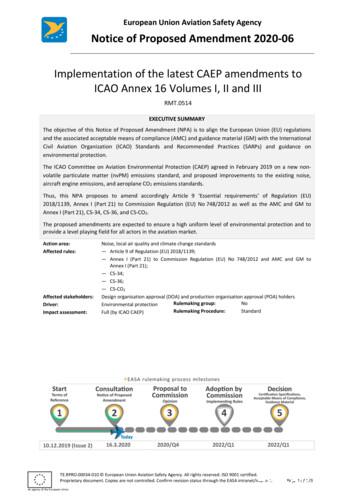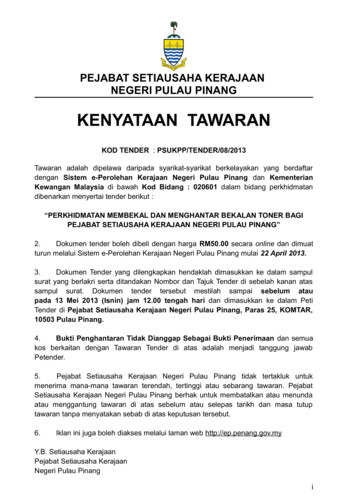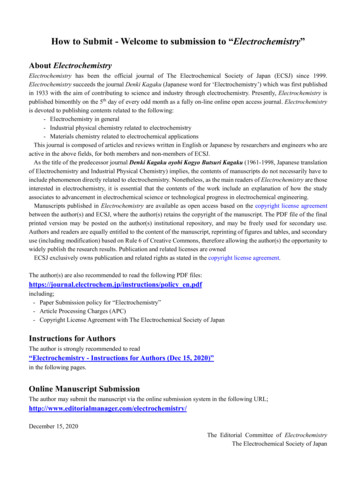ICAO Flightplan Form Basics - EuroFPL
Some verbiage and examples adapted directly from PANS-ATM ICAO Doc 4444 Amdt 1. For EuroFPL use and reference only.ICAO Flightplan Form Basics1DATE OF FLIGHTSix-digit date of flight in the format “YYMMDD”, where “YY”is the last two digits of the year, “MM” is a two-digitrepresentation of the month, and “DD” is a two-digitrepresentation of the calendar day (all with leading zeroeswhere necessary).i.e. 121015, 130122.27 AIRCRAFT IDENTIFICATIONAircraft registration letters/tail number or an ICAO agencydesignator with flight number. ICAO 2012 strictly enforcesthat this figure should be letters and numbers only, devoidof dashes, spaces, or other punctuation.i.e. N123B, GCABC, KLM672, SWIFT45.3i.e. Departing VFR, cruising IFR, and landing VFR? File Z.TYPE OF FLIGHTDenotes the type of flight as follows: “S” for Scheduled AirService, “N” for Non-scheduled Air Transport Operation, “G”for General Aviation, “M” for Military, and “X” for everythingelse. Other special flight status and handling considerationscan be relayed via the 18 OTHER INFORMATION field’s “STS/”and “RMK/” indicators.59 NUMBERNumber of aircraft in flight, if more than one. This figure isomitted if the flight is only a solo aircraft movement.6As of ICAO 2012, the date of flight (DOF/) figure is morewidely recognized, and many more authorities worldwide will now accept filings as far out as five days ahead.The [ 1] [ 3] and [ 24 hrs] links will automatically setTIME and DATE OF FLIGHT figures 1, 3, or 24 hours aheadof the current time. If these fields aren’t filled in, thesystem will presume a departure in one hour. If a TIMEvalue is entered that is before, or less than 30 minutesahead of, the current time, DATE OF FLIGHT will fillautomatically with the next day’s date. Otherwise, thecurrent date will be entered.8 FLIGHT RULESDenotes the category of flight rules: “I” for IFR, “V” for VFR,“Y” for when the flight will be initially IFR followed by one ormore subsequent flight rules changes, and “Z” for VFR firstwith any number of subsequent changes. When a “Y” or “Z”flight is prepared, “VFR” or “IFR must be entered in the routestring wherever the transitions/changes to the flight rulesare planned to occur.4Did you know?TYPE OF AIRCRAFTType of aircraft, as specified in the latest ICAO Doc 8643, bythe appropriate designator. A search for this designatorcode can be performed online Search.aspxIf no designator exists for your aircraft, or there is more thanone type of aircraft in your flight, enter “ZZZZ” here andspecify number and type(s) in 18 OTHER INFORMATIONpreceded by “TYP/” tags.i.e. P46T, EA50, C182.125634
Some verbiage and examples adapted directly from PANS-ATM ICAO Doc 4444 Amdt 1. For EuroFPL use and reference only.ICAO Flightplan Form Basics1WAKE TURBULENCE CAT.Wake turbulence category of aircraft as specified in ICAODoc 8643 or based on weight and the following options: “L”for Light ( 7,000 kg), “M” for Medium (7,000 to 136,000 kg),“H” for Heavy ( 136,000 kg), and “J” for Jumbo(exceptionally heavy aircraft such as the Airbus A380-800). Asearch for the category can be performed online Search.aspx210 EQUIPMENTThe ICAO 2012 amendment includes extensive changes tothe COM/NAV equipment codes used in the FPL messageformat. These changes and EuroFPL’s helpful ICAO 2012Equipment Wizard are explained in-depth on the next page(Page 3) of this briefing.3Did you know?The nature and scope of the [ICAO 2012] amendment is toupdate the ICAO model flight plan form in order to meetthe needs of aircraft with advanced capabilities and theevolving requirements of automated air traffic management (ATM) systems, while taking into account compatibility with existing systems, human factors, training, costand transition aspects."ICAO State Letter (AN 13/2.1-08/50) - 25 June 200813 DEPARTURE AERODROMEFour-character location indicator of the departureaerodrome, “AFIL” if filed in the air, or “ZZZZ” if no officialdesignator exists in ICAO Doc 7910. In the latter cases, ICAO2012 strictly states that the aerodrome name or primary fixwith location (degrees and minutes ddmmNdddmmEformat preferred) be entered in 18 OTHER INFORMATIONpreceded by a “DEP/” tag.1i.e. EKRK, BIKF, LFPG, CYYR, ZZZZ.4TIMEPlanned time of departure (UTC) in 24-hour “HHMM” format,where “HH” is a two-digit representation of the hour, and“MM” is a two-digit representation of the minutes past thehour (with leading zeroes where necessary).i.e. 0615, 1342, 2305.515 CRUISING SPEEDTrue airspeed for the initial or whole cruise segment of theflight, indicated as: “N” for Knots, followed by a four-digitfigure, “M” for Mach number followed by a three-digitrepresentation of ratio, or “K” for Kilometers/hour followedby a four-digit number.i.e. K0830, N0485, M082.6LEVELPlanned cruising level for the initial or whole cruise segmentof the flight, indicated as: “F” for Flight Level in 100s of feet,“A” for plain altitude in 100s of feet (both three-digit), “S” forStandard Metric Level in tens of metres, “M” for plainaltitude in tens of metres (both four-digit), or “V” foruncontrolled VFR (number field left blank).i.e. F330, M0840, A045.34562
The Equipment Wizard aims to provide users with an organized graphical interface for the many equipment designators employed in this new format. Inputcan be achieved by typing codes directly into the text fields, or by selecting the checkboxes for equipment carried. NIL can be selected under either columnto signify that there is no equipment and/or surveillance capability for the aircraft. Clicking the option will reveal the various items as follows:ICAO Flightplan Form Basics10 EQU IP M ENT -- Euro FPL ICAO 2012 Eq u ip men t Wiz a rdEQUIPMENTVHF RTF/VOR/ILS (S) - Standard COM/NAV SetupGBAS (A) - Ground Based Augmentation SystemLPV (APV/SBAS) (B) - Localizer Performance withVertical Guidance (Infers Satt.-Based Augmentation)LORANC (C) - LORAN-C RadionavigationDME (D) - Distance Measurement EquipmentACARS (Multiple) - Addressing and Reporting SystemADF (F) - Automatic Direction FinderGNSS (G) - Global Navigation Satellite SystemGNSS augmentation “NAV/” data in Field 18 optional.HF RTF (H) - HF RadiotelephoneINERTIAL NAV (I) - Aircraft Inertial GuidanceCPDLC (Multiple) - Controller-Pilot Data LinkMLS (K) - Microwave Landing SystemILS (L) - Instrument Landing SystemATC RTF SATCOM (Multiple) - Radiotelephone Satt.VOR (O) - VHF Omnidirectional Radio RangePBN (R) - Performance-Based NavigationPBN requires corresponding “PBN/” data in Field 18.TACAN (T) - Tactical Air Navigation SystemUHF RTF (U) - UHF RadiotelephoneVHF RTF (V) - VHF RadiotelephoneRVSM (W) - Reduced Vertical Separation MinimumMNPS (X) - Minimum Navigation Performance Spec.VHF 8.33 (Y) - 8.33 kHz Radio Channel SpacingOTHER (Z) - Other Item(s) Not Listed AboveOTHER requires corresponding “COM/”, “NAV/” or “DAT”.SURVEILLANCEMODE A (A) - Mode A TransponderMODE A/C (C) - Mode A Transponder with Mode CS/[.] (Multiple) - Mode S Transponder with or without.ID - Aircraft Identification PALT - Pressure AltitudeADS-B - Surveillance Broadcast DLINK - Data LinkMODE S (S) - Mode S TransponderADS-B/1090 MHz (Multiple) -1090 MHz Out/InADS-B/UAT (Multiple) - Universal Access Trans. Out/InADS-B/VDL M4 (Multiple) - VHF Digital Mode 4 Out/InADS-C/FANS 1/A (D1) - Sur. Contract Future Air Nav.ADS-C/ATN (G1) - Sur. Contract Aeronautical TelecomKey Changes:* New indicators added to describe complex compliment items.* The S indicator “VHF RTF/VOR/ILS” is no longer inclusive of ADF.* If “PBN” is specified, Field 18 requires corresponding “PBN/” data.* If “OTHER” is specified, Field 18 requires “COM/”, “NAV/”, or “DAT/”.For a good overall online reference see also:http://contentzone.eurocontrol.int/FPL/
Some verbiage and examples adapted directly from PANS-ATM ICAO Doc 4444 Amdt 1. For EuroFPL use and reference only.ICAO Flightplan Form Basics1ROUTEA string of points (and connecting airways or DCTs whereapplicable) describing an ATS route or path of fixes no morethan 30 minutes flying time or 200nm apart, including thosepoints where a change of speed, level, track, or flight rules isplanned. Points can be listed by their coded designator (i.e.LN, MAY, HADDY), a 7 or 11-character representation of theircoordinates (i.e. 46N078W, 4620N07805W), or a pointrelative to a reference point based on bearing and distance(i.e. DUB190040 being 40nm out on the 190 degreemagnetic bearing from DUB).Did you know?If you don't enter a TOTAL EET figure, a temporary figureis automatically calculated upon STORE/UPDATE that isbased on great circle distance and basic cruise speed (nowinds) to allow for easy validation of the flightplan. Afterrunning a navigation log, a more accurate TOTAL EETfigure can be entered along with “EET/” entries in the 18OTHER INFORMATION field where appropriate.Change of speed and/or level is indicated by appendingdata formatted as in 15 CRUISING SPEED and LEVEL to apoint, after a slash (i.e. MAY/N0305F180,46N078W/M082F330). Change of flight rules are shown by astandalone “VFR” or “IFR” to indicate the beginning of thatphase of flight.216 DESTINATION AERODROMEFour-character location indicator of the destinationaerodrome or “ZZZZ” if no official designator exists in ICAODoc 7910. In the latter case, ICAO 2012 strictly states thatthe aerodrome name or final fix with location (degrees andminutes ddmmNdddmmE format preferred) be entered in18 OTHER INFORMATION preceded by a “DEST/” tag.i.e. EKRK, BIKF, LFPG, CYYR, ZZZZ.3TOTAL EETTotal estimated enroute time in “HHMM” format, where“HH” is a two-digit representation of the hours and “MM” is atwo-digit representation of minutes in flight (with leadingzeroes where necessary).i.e. 0142, 0305, 0047.4i.e. EKRK, BIKF, LFPG, CYYR, ZZZZ.18 OTHER INFORMATIONThe ICAO 2012 amendment includes extensive changes tothe way data is presented and ordered for Field 18 data inthe FPL message format. These changes and EuroFPL’shelpful ICAO 2012 Other Information Wizard are explainedin-depth on the next page (Page 5) of this briefing.62(2ND) ALTN AERODROMEFour-character location indicator of the alternateaerodrome(s) or “ZZZZ” if no official designator exists inICAO Doc 7910. In the latter case, ICAO 2012 strictly statesthat the aerodrome name(s) with location (degrees andminutes ddmmNdddmmE format preferred) be entered in18 OTHER INFORMATION preceded by a “ALTN/” tag.5119 ENDURANCETotal fuel endurance in “HHMM” format, where “HH” is atwo-digit representation of the hours and “MM” is atwo-digit representation of minutes of fuel (with leadingzeroes where necessary).i.e. 0142, 0305, 0047.5634
The Other Information Wizard aims to provide users with an organized graphical interface for the many new designators employed in the new ICAO 2012format. Input can be achieved by typing data directly into the text box, or by selecting an indicator type from the menu and entering data into thecorresponding row. For the best success, the data fields should only contain alphanumerical characters and spaces. Other punctuation may be forbidden.ICAO Flightplan Form Basics1 8 O T H ER INFO RMA TIO N -- Euro FPL ICAO 2012 Ot h er In fo rma tio n Wiz ar dSTS/ - Indicators for Special Handling by ATSPBN/ - RNAV and/or RNP Capability Indicators*EUR/ - Protected Status Indicator for IFPSNAV/ - Nav. Equipment Data and GNSS Augmentationi.e. NAV/SBASCOM/ - Comm. Equipment Not Specified in Field 10DAT/ - Data Capabilities Not Specified in Field 10SUR/ - Surveillance Capabilities Not Specified in Field 10DEP/ - Name/Coords (ddmmNdddmmE) of DepartureAerodrome When “ZZZZ” Specified in Field 13i.e. DEP/CROSLAND 5337N00149WDEST/ - Name/Coords (ddmmNdddmmE) of DestinationAerodrome When “ZZZZ” Specified in Field 16i.e. DEST/VENLO 5123N00603EREG/ - Aircraft Registration if Different Than Field 7EET/ - Estimated Enroute Time(s) in “HHMM” format toSignificant Fixes or FIR Boundariesi.e. EET/CAP0745 EHAA0830SEL/ - SELCAL Code For Applicable AircraftTYP/ - Number and Type(s) of Aircraft if “ZZZZ” in Field 8CODE/ - Aircraft Address Code in Six Hexadecimal Chars.*RVR/ - Runway Visual Range Requirement in MetresDLE/ - Enroute Delay or Holding Point with “HHMM” Timei.e. DLE/MDG0030OPR/ - ICAO Designator or Name of Aircraft OperatorPER/ - Aircraft Performance Category Where ApplicableALTN/ - Name/Coords (ddmmNdddmmE) of DestinationAlternate Aerodromes if “ZZZZ” in Field 16.i.e. ALTN/TOUL 4846N00558ERALT/ - Enroute AlternatesTALT/ - Take-off AlternatesRIF/ - Route Details to Revised Destination AerodromeRMK/ - Plain Language Remarks Where Necessary*STAYINFO/ - IFPS Indicators for Stay Activity*RFP/ - Replacement Flightplan Indicator for IFPS* For IFPS Flights OnlyKey Changes:* New indicators have been introduced, some retracted.* The sequence that indicators should appear in is now compulsory.* Any given indicator can only appear ONCE in Field 18.* Hyphen (-) and oblique stroke (/) characters forbidden in data.* “STS/” indicator is no longer free-text.* “PBN/” is now mandatory to detail PBN equipment capabilities.* “NAV/” entry is required when GNSS equipment is specified.For a good overall online reference see le entries of the same type will be automatically concatenatedexcept for items such as STAYINFO entries which will be numericallysequenced in the order that they appear.
Some verbiage and examples adapted directly from PANS-ATM ICAO Doc 4444 Amdt 1. For EuroFPL use and reference only.ICAO Flightplan Form Basics1PERSONS ON BOARDTotal number of persons including passengers and crew thatwill be onboard, or “TBN” (To Be Notified) if unknown at timeof filing.2EMERGENCY RADIOPlease note that any available equipment or features shouldbe CLICKED ON here. The printable PDF version of the formwill reverse these selections as per the convention ofcrossing out equipment and features that are not available.Select “UHF” here if you are able to receive and xmit at 243.0MHz, “VHF” here if you are able to receive and xmit at 121.5MHz, and/or “ELBA” if an emergency location beacon ispresent on the plane.3Did you know?Due to ICAO Doc 4444 convention and the strict nature ofmany authorities Flight Data Managers, flightplansupplemental data is often only transmitted to AROs andother full-service offices, and not included when transmitting directly to towers and area controllers. Because ofthis, it is often wise to copy your pilot contact info (phone)to an 18 OTHER INFORMATION “RMK/” entry, so that youcan be contacted directly by all parties if a timelyresolution is sought for any issues with your flight.SURVIVAL EQUIPMENTPlease note that any available equipment or features shouldbe CLICKED ON here. The printable PDF version of the formwill reverse these selections as per the convention ofcrossing out equipment and features that are not available.Select the appropriate items indicating what types ofsurvival equipment, if any, are carried.4JACKETSPlease note that any available equipment or features shouldbe CLICKED ON here. The printable PDF version of the formwill reverse these selections as per the convention ofcrossing out equipment and features that are not available.Select “LIGHT” if your life jacket(s) are lighting equipped,“FLUORES” if fluorescein equipped, and “UHF” or “VHF” ifradio equipped.5DINGHIES (NUMBER)The number of survival dinghies carried onboard. Leaveblank if none.6DINGHIES (CAPACITY)1Total capacity, in persons, of all dinghies carried. Leaveblank if none.35246
Some verbiage and examples adapted directly from PANS-ATM ICAO Doc 4444 Amdt 1. For EuroFPL use and reference only.ICAO Flightplan Form Basics1DINGHIES (COVER)Check this box if the dinghies have protective canopies.2DINGHIES (COLOR)Plain text description of the dinghies primary color.3AIRCRAFT COLOR AND MARKINGSPlain text description of aircraft color and any significantlivery markings or characteristics.4Did you know?Custom PREFERRED CONTACT settings (such as ACKmessages via SMS) for a pilot are going to be dependanton the PILOT-IN-COMMAND value attached to aflightplan. Our system will typically look to the exactvalue provided by the Flightplan Builder’s Load Pilotmenu to determine what custom contact settings tohonor for an operational message. This value typicallyincludes the pilot’s surname, first initial, and mobilecontact number.REMARKSIndicate any other survival equipment carried and/or otherremarks specifically regarding survival equipment andsearch-and-rescue (SAR) information.5PILOT-IN-COMMANDName and preferably phone contact information of the pilotin command. Including phone contact information helps inthose rare cases that timely clarification or further information is required by ATC accepting the flight.13452
Total fuel endurance in “HHMM” format, where “HH” is a two-digit representation of the hours and “MM” is a two-digit representation of minutes of fuel (with leading zeroes where necessary). 19 ENDURANCE The ICAO 2012 amendment includes extensive changes to the way data is presented and ordered for Field 18 data in the FPL message .
ICAO Doc 9184, Airport Planning Manual, Parts 1 to 3; ICAO Doc 9261, Heliport Manual; ICAO Doc 9332, Manual on the ICAO Bird Strike Information System (IBIS); ICAO Doc 9365, Manual of All-Weather Operations; ICAO Doc 9426, Air Traffic Services Planning Manual; ICAO Doc 9476, Manual of Surface Movement Guidance and Control Systems (SMGCS); ICAO .
ICAO Doc 9683, Human Factors Training Manual; ICAO Doc 9734, Establishment and Management of a State‘s Safety Oversight System; ICAO Doc 9760, Airworthiness Manual, Volumes I and II; ICAO Doc 9774, Manual on Certification of Aerodromes; ICAO Doc 9815, Manual on Laser Emitters and Flight Safety; ICAO
CHAPTER 2 - ICAO STATE LETTERS (ANNEX AMENDMENTS) 2.1 Notification of amendment to an ICAO Annex. 2.1.1 Proposals to amend an ICAO Annex are notified by an ICAO technical State letter. Amendment to regulations (involving rule/ Civil Aviation Requirements) is initiated as a re
(a) ICAO Doc 8168 Volumes I and II - Procedures for Air Navigation Services – Aircraft Operations (PANS-OPS) (b) ICAO Doc 9368 – IFP Construction Manual (c) ICAO Doc 9371 – Template Manual (d) ICAO Doc 9724 – CRM Manual (e) ICAO Doc 9365 – All Weather Operations Manual
The latest amendments to the ICAO SARPs considered in this RMT are: — ICAO Annex 16 Volume I, latest edition including Amendment 13, — ICAO Annex 16 Volume II, latest edition including Amendment 10, — ICAO Annex 16 Volume III, latest edition including Amendment 1, —
1.3 This BAR is based mainly on compliance with the following ICAO documents: (a) ICAO Annex 10 Volumes I to V – Aeronautical Telecommunications; (b) ICAO Annex 11 – Air Traffic Service; (c) ICAO Annex 19 – Safety Management; (d) ICAO Doc 8071 Volumes I to III – Testing of Ground-based and Satellite-
ICAO NACC Regional Office Page 8 . Annex 14 - Aerodromes, Volume I - Aerodrome Design and Operations . Wildlife strike reports shall be collected and forwarded to ICAO for inclusion in the ICAO Bird Strike Information System (IBIS) database. Information on the system is included in the . Manual on the ICAO Bird Strike Information System (IBIS)
pihak di bawah koordinasi Kementerian Pendidikan dan Kebudayaan, dan dipergunakan dalam tahap awal penerapan Kurikulum 2013. Buku ini merupakan “dokumen hidup” yang senantiasa diperbaiki, diperbaharui, dan dimutakhirkan sesuai dengan dinamika kebutuhan dan perubahan zaman. Masukan dari berbagai kalangan diharapkan dapat meningkatkan kualitas buku ini. Kontributor Naskah : Suyono . Penelaah .























